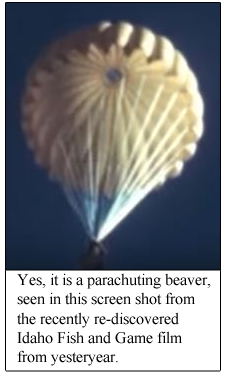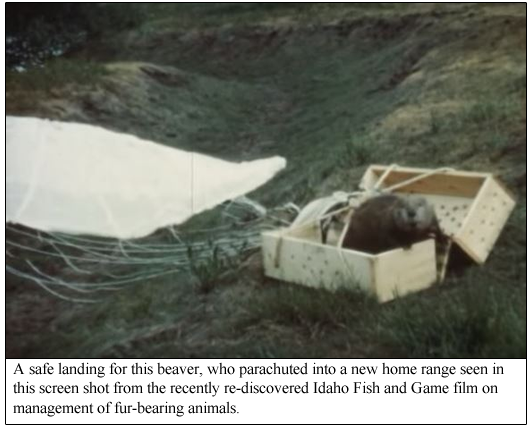|
|
|
Parachuting beavers go global |
|
October 28, 2015 |
It wasn't exactly an unreleased Beatles tune or
a missing Monet, but the much-talked-about film
featuring parachuting beavers was recently
rediscovered in Fish and Game's archives.
The 1950s film "Fur for the Future" produced by
the department highlighted Fish and Game's
efforts to transplant muskrats, marten and
beavers, which included parachuting beavers into
the back-country.
Working with the Idaho Historical Society, Fish
and Game staff were able to find the film which
was found in a mislabeled box.
 Last
week, Idaho Fish and Game released the long-lost
film. The film documented a project to
repopulate backcountry wilderness areas of Idaho
with beaver—pretty routine work in the late
1940s and early 1950s. However, add parachutes,
specially designed boxes and aircraft into the
mix, and the story becomes one of wildlife
management’s most interesting tales. And it has
not gone unnoticed. Last
week, Idaho Fish and Game released the long-lost
film. The film documented a project to
repopulate backcountry wilderness areas of Idaho
with beaver—pretty routine work in the late
1940s and early 1950s. However, add parachutes,
specially designed boxes and aircraft into the
mix, and the story becomes one of wildlife
management’s most interesting tales. And it has
not gone unnoticed.
Parachuting beavers have captured the attention
of people all around the world. Since it was
posted, 471,000 viewers have checked out the
film on the Fish and Game YouTube Channel. Calls
from radio stations and newspapers for
interviews have come in from across the country
including San Francisco, Orlando, Dallas, New
York City and the heartland. The Canadian
Broadcasting Corporation ran a piece from
Toronto.
But the interest does not end in North America.
From Brazil to India to Australia to the United
Kingdom and beyond, beavers are parachuting onto
radio programs, newspapers and websites. There
is just something about a 40-pound rodent safely
floating to its new home tucked in a box at the
end of a WWII-era parachute. Slightly
unbelievable, somewhat strange, definitely true,
and ultimately successful, it’s just the story
for the lead-up to Halloween.
If you have not yet seen this fascinating look
at wildlife management of yesteryear, check it
out by
clicking here.
 |
|
|
|
Questions or comments about this
article?
Click here to e-mail! |
|
|
|
|

